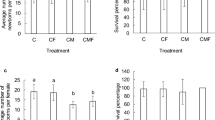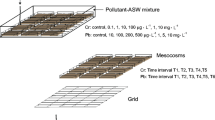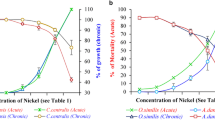Abstract
1. Introduction
In order to evaluate Cobalt 60 behavior in freshwater ecosystems, two food chains including different nutritionally interdependent species in a natural environment were defined: CHLORELLA → DAPHNIA → CARP Chlorophyceae Crustacea Fish ELODEA → LYMNAEA → CRAYFISH Phanerogamia Mollusca Crustacea
This article will cover the dynamics of water-borne contamination in the above species.
2. Experimental Procedures
-
2.1.
EXPERIMENTAL CONDITIONS
Table I outlines the basic experimental conditions.
In each case, Cobalt 60 was introduced into water in chloride form in HCI solution. Except for Chlorella culture medium, radioactivity levels of water were readjusted at regular intervals throughout the investigation.
-
2.2.
SAMPLING METHODS
Water samples were filtered to 0.45 μm and activity levels were measured separately in the soluble and particulate forms.
Chlorella were separated by centrifugation then rinsed in non-radioactive water and centrifuged again. Radioactivity was measured in the living cells. The algae were then oven-dried and their dry weight recorded: fresh weight was estimated at five times the measured dry weight.
For the other species, radioactivity was measured on living specimens and related to fresh weight.
-
2.3.
RADIOACTIVITY MEASUREMENTS
They were carried out by y-spectrometry, with suitable allowance for the detection system efficiency and geometry effects.
3. Results and Discussion
-
3.1.
CHLORELLA
It was observed that Cobalt 60 accumulation was fast; peak value was reached within 24 h (figure 1), with a mean concentration factor versus water of 565 (Table II).
-
3.2.
CARP
Environmental equilibrium conditions were reached on the 32nd day (Figure 1), with a mean concentration factor of 3.4 (Table II).
-
3.3.
ELODEA
Contamination kinetics are shown on Figure 2. Under equilibrium conditions mean concentration factors ranged from 4037 to 4410 according to activity levels in water (Table II).
-
3.4.
LYMNAEA
Equilibrium was reached after four to six weeks, with mean concentration factors between 401 and 1038 according to radioactivity levels in water (Figure 2 and Table II).
-
3.5.
CRAYFISH
The equilibrium concentration factors ranged from 40, in group A, to above 394 for individuals in group A, to above 394 for individuals in group B, (Figure 2). These variations might be related to the condition of the exoskeleton between molts.
Our experimental result were compared with other published data (Tables III and IV)
4. Conclusion
Concentration factors obtained in laboratory conditions are of limited value for extrapolation to environmental contamination; however, such experimental data do have a relative value. Generally the most highly contaminated species were the primary elements in the food chain, particularly macrophytes. Radioactivity levels in animal species decreased directly with increasing zoological complexity, which in turn generally correspondended to a higher trophic level.
This factor must be considered during subsequent research on Cobalt 60 transfer in ecosystem through the food vector.
Similar content being viewed by others
Bibliographie
Amiard-Triquet, C.: 1975, Etude du transfert des radionucléides entre le milieu sédimentaire marin et les Invertébrés qui y vivent, Rapport CEA-R-4705.
Amiard, J.-C. et Amiard-Triquet, C.: 1977, Intern. J. Environmental Studies 10, 113.
Amiard-Triquet, C. et Amiard, J.-C.: 1975, Helgolander wiss. Meeresunters27, 283.
André, M.: 1960, LesEcrevissesfrançaises, Paul Lechevalier, Paris, 293 pp.
Antonelli, A., Castaldo, M., Cigna Rossi, L., Laneri, U., et Pagnotta, R.: 1972, in La Radioécologie appliquée d la Protection de l'Homme et de son Environnement, Rom, 7–10 Sept. 1971, CCE, Luxembourg, Rapport EUR 4800 d-f-i-e, pp. 1305–1320.
Carlander, K. D.: 1970, Handbook of Freshwater Fishery Biology, Iowa State University Press, Ames, Iowa.
Churchill, M. A., Cragwall, J. S., Andrew, R. W., et Jones, S. L.: 1965, ‘Concentrations, Total Stream Loads and Mass Transport of Radionuclides in the Clinch and Tennessee Rivers’, ORNL-3721, Suppl. 1.
Commission des Communautés Européennes: 1974, Effluents radioactifs des centrales nucléaires de la Communauté. Bilan des rejets. Aspects radiologiques, C.C.E., Luxembourg.
Copeland, R. A. et Ayers, J. C.: 1972, in Environmental Research Group Special Report Nb. 1, Great Lakes Research Division, Univ. Michigan, Ann Harbor.
Delamare-Deboutteville, C.: 1963, in Zoologie, Encyclopédie de la Pléïade, Gallimard, Paris, 2, pp. 259–410.
Electricité de France: 1974, Radioprotection 9, 141.
Frömming, E.: 1956, Biologie derMitteleuropäischen süsswasserschnecken, Duncker et Humblot, Berlin.
Gileva, E. A.: 1960, Dokl. Akad. Nauk. SSSR 132, 948.
Harvey, R. S.: 1970, Health Phys. 19, 293.
Kevern, N. R. et Griffith, N. A.: 1966, in Radiation Ecology Section, Health Physics Division, Ann. Prog. Rep. ORNL-4007.
Kovalsky, V. V. et, Letunova,S. V.: 1961, Zool. Zhur. 40, 809.
Mahmoud, K. A., Yousef, Y. A., Ishak, M. M., Abdel-Malik, W. E. Y., Khalil, S. R., Shafik, A., et El-Shirawy, R. M. K.: 1973, Environmental Behaviour of Radionuclides Released in the Nuclear Industry, Symposium Proceedings, Aix-en-Provence, IAEA, Vienna, pp. 205–215.
Martin, J. J. et Beau, P.: 1972, in VIe Congrès Intern. Soc. Française de Radioprotection, Bordeaux, 27–30 Mars, 1972, pp. 871–886.
Merlini, M., Bibliocca, C., Berg, A., et Pozzi, G.: 1971, Nuclear Techniques in the Measurement and Control of Environmental Pollution, Symposium Proceedings, Salzburg, IAEA, Vienna, pp. 447–457.
Morgan, G. B.: 1961, Quart. J. Florida Acad. Sci. 24(2), 7.
Morton, R. J.: 1965, Status Report No. 5 on Clinch River Study, ORNL-3721.
Moyse, A. et Yvon, A.: 1956, J. Recherches C.N.R.S. 35, 169.
Nicolas, C. et Kirchmann, R.: 174, Contamination of freshwater fish by 54 Mn and 60 Co, Rapport EUR 5167 e.
Ophel, I. L. et Fraser, C. D.: 1971, in D. J. Nelson, (ed.), Proc. 3rd Nat. Symp. Radioecol., 10–12 May, 1971, Oak Ridge, Tennessee, pp. 323–327.
Paoletti, A., Bartoli, G., Parrella, A., et Sandhelli, G.: 1973, NuoviAnn. Ig. Microbiol. 24, 252.
Paoletti, A., Bartoli, G., et Parrella, A.: 1976a, L'igiene moderna 69, 119.
Paoletti, A., Bartoli, G., et Parrella, A.: 1976b, Antologia di medicina e igiene 14(4), 1.
Parker, M.: 1966, Studies on the Distribution of Cobalt in Lakes, Ph.D. Thesis, Univ. of Wisconsin, Madison, 74 pp.
Patel B.: 1975, Design of Radiotracer Experiments in Marine Biological Systems, IAEA, Tech. Rep. Ser. 167, pp.211–239.
Price, K. R.: 1971, A Critical Review of Biological Accumulation, Discrimination and Uptake of Radionuclides Important to Waste Management Practices, 1943–1971, Rep. BNWL-B-148.
Ptak, M.: 1971, in Interactions entre cations métalliques et macromolecules biologiques, Ecole d'été, Roscoff, CNRS, Paris, 47.
Queirazza, G. et Smedile, E.: 1974, G. Fis. Sanit. Prot. Radiaz. 18 (1–2), 17.
Schäperclaus, W.: 1962, TraW de pisciculture en étang, Vigot frères, Paris.
Smith, E. L.: 1962, in C. L. Comar et F. Bronner (eds.),Mineral Metabolism, Vol. 2B, Academic Press, New York, pp. 349–369.
Smith, E. L.: 1965, Vitamin B 12, Methuen, London.
Timofeeva-Resovskaya, E. A.: 1963, Trudy Inst. Biol. Akad. Nauk SSSR 30, 1; Rep. JPRS 21, 816, TT 63–41112.
Timofeeva-Resovskaya, E. A. et Timofeev-Resovskii, N. V.: 1958, Bull. Moskov. Isp. Prirody 63(5), 123, CEA-Tr-R-1890.
Underwood, E. J.: 1971, Trace Elements in Human and Animal Nutrition, Academic Press, New-York, pp. 141–169.
Vanderploeg, H. A., Parzyck, D. C., Wilcox, W. H., Kercher, J. R., et Kaye, S. V.: 1975, Bioaccumulation Factors for Radionuclides in Freshwater Biota, ORNL-5002.
Wiser, C. W. et Nelson, D. J.: 1964, The Amer. Midl. Natur. 72(1), 181.
Author information
Authors and Affiliations
Rights and permissions
About this article
Cite this article
Amiard-Triquet, C., Foulquier, L. Modalites de la contamination de deux chaines trophiques dulcaquicoles par le cobalt 60: I: Contamination directe des organismes par l'eau. Water Air Soil Pollut 9, 475–489 (1978). https://doi.org/10.1007/BF00213543
Received:
Revised:
Issue Date:
DOI: https://doi.org/10.1007/BF00213543




